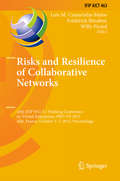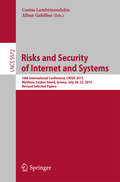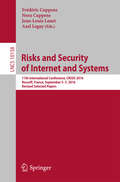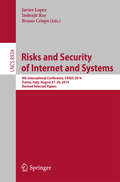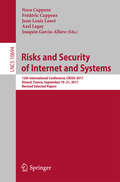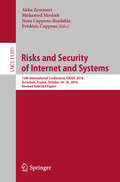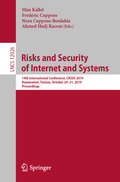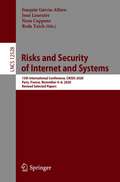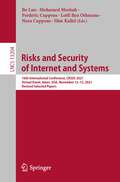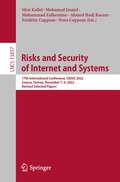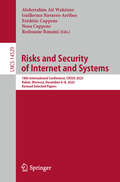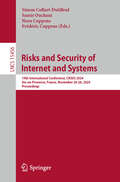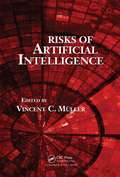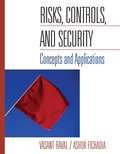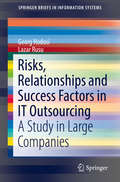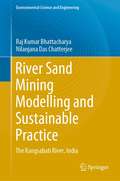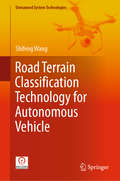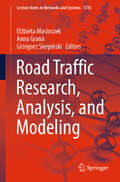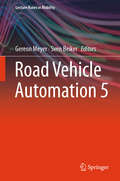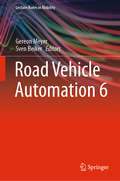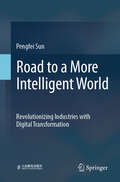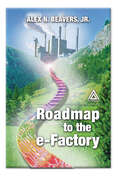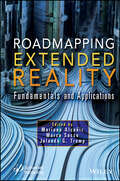- Table View
- List View
Risks and Resilience of Collaborative Networks
by Frédérick Bénaben Luis M. Camarinha-Matos Willy PicardThis book constitutes the refereed proceedings of the 16th IFIP WG 5. 5 Working Conference on Virtual Enterprises, PRO-VE 2015, held in Albi, France, in October 2015. The 61 revised papers were carefully selected from 126 submissions. They provide a comprehensive overview of identified challenges and recent advances in various collaborative network (CN) domains and their applications, with a strong focus on the following areas: risks in collaborative networks; agility and resilience in collaborative networks; collaboration frameworks; logistics and transportation; innovation networks; governance in collaborative networks; collaborative communities; information and assets sharing; business processes; performance and optimization; and network formation.
Risks and Security of Internet and Systems
by Costas Lambrinoudakis Alban GabillonThis book constitutes the thoroughly refereedpost-conference proceedings of the 10th International Conference on Risks andSecurity of Internet Systems, CRiSIS 2015, held in Mytilene, Lesbos Island,Greece, in July 2015. The 18 full papers presented were selected from 50 submissions. The papers sessions that have covered a broad range of topics: trust and privacyissues, privacy policies and policy based protocols, risk management, riskanalysis and vulnerability assessment, cloud systems and cryptography, andattack and security measures.
Risks and Security of Internet and Systems
by Frédéric Cuppens Axel Legay Nora Cuppens Jean-Louis LanetThis book constitutes the revised selected papers from the 11th International Conference on Risk and Security of Internet and Systems, CRISIS 2016, held in Roscoff, France, in September 2016. The 17 full papers presented in this volume were carefully reviewed and selected from 24 submissions. They cover diverse research themes, ranging from classic topics, such as intrusion detection, applied cryptography, formal methods and methodology for risk and security analysis, to emerging issues, such as ransomware and security of software defined networking or virtualization techniques.
Risks and Security of Internet and Systems
by Javier Lopez Indrajit Ray Bruno CrispoThis book constitutes the thoroughly refereed post- conference proceedings of the Ninth International Conference on Risks and Security of Internet Systems, CRiSIS 2014, held in Trento, Italy, in August 2014. The 13 full papers and 6 short papers presented were selected from 48 submissions. They explore risks and security issues in Internet applications, networks and systems covering topics such as trust, security risks and threats, intrusion detection and prevention, access control and security modeling.
Risks and Security of Internet and Systems: 11th International Conference, Crisis 2016, Roscoff, France, September 5-7, 2016, Revised Selected Papers (Lecture Notes in Computer Science #10158)
by Frédéric Cuppens Joaquin Garcia-Alfaro Axel Legay Nora Cuppens Jean-Louis LanetThis book constitutes the revised selected papers from the 12th International Conference on Risk and Security of Internet and Systems, CRISIS 2017, held in Dinard, France, in September 2017.The 12 full papers and 5 short papers presented in this volume were carefully reviewed and selected from 42 submissions. They cover diverse research themes, ranging from classic topics, such as vulnerability analysis and classification; apps security; access control and filtering; cloud security; cyber-insurance and cyber threat intelligence; human-centric security and trust; and risk analysis.
Risks and Security of Internet and Systems: 13th International Conference, CRiSIS 2018, Arcachon, France, October 16–18, 2018, Revised Selected Papers (Lecture Notes in Computer Science #11391)
by Nora Cuppens-Boulahia Frédéric Cuppens Akka Zemmari Mohamed MosbahThis book constitutes the revised selected papers from the 13th International Conference on Risks and Security of Internet and Systems, CRiSIS 2018, held in Arcachon, France, in October 2018. The 12 full papers and 6 short papers presented in this volume were carefully reviewed and selected from 34 submissions. They cover diverse research themes that range from classic topics, such as vulnerability analysis and classification; apps security; access control and filtering; cloud security; cyber-insurance and cyber threat intelligence; human-centric security and trust; and risk analysis.
Risks and Security of Internet and Systems: 14th International Conference, CRiSIS 2019, Hammamet, Tunisia, October 29–31, 2019, Proceedings (Lecture Notes in Computer Science #12026)
by Nora Cuppens-Boulahia Frédéric Cuppens Slim Kallel Ahmed Hadj KacemThis book constitutes the revised selected papers from the 14th International Conference on Risks and Security of Internet and Systems, CRiSIS 2019, held in Hammamet, Tunisia, in October 2019.The 20 full papers and 4 short papers presented in this volume were carefully reviewed and selected from 64 submissions. They cover diverse research themes that range from classic topics, such as risk analysis and management; access control and permission; secure embedded systems; network and cloud security; information security policy; data protection and machine learning for security; distributed detection system and blockchain.
Risks and Security of Internet and Systems: 15th International Conference, CRiSIS 2020, Paris, France, November 4–6, 2020, Revised Selected Papers (Lecture Notes in Computer Science #12528)
by Joaquin Garcia-Alfaro Nora Cuppens Jean Leneutre Reda YaichThis book constitutes the proceedings of the 15th International Conference on Risks and Security of Internet and Systems, CRiTIS 2020, which took place during November 4-6, 2020. The conference was originally planned to take place in Paris, France, but had to change to an online format due to the COVID-19 pandemic. The 16 full and 7 short papers included in this volume were carefully reviewed and selected from 44 submissions. In addition, the book contains one invited talk in full paper length. The papers were organized in topical sections named: vulnerabilities, attacks and intrusion detection; TLS, openness and security control; access control, risk assessment and security knowledge; risk analysis, neural networks and Web protection; infrastructure security and malware detection.
Risks and Security of Internet and Systems: 16th International Conference, CRiSIS 2021, Virtual Event, Ames, USA, November 12–13, 2021, Revised Selected Papers (Lecture Notes in Computer Science #13204)
by Frédéric Cuppens Nora Cuppens Mohamed Mosbah Lotfi Ben Othmane Slim Kallel Bo LuoThis book constitutes the proceedings of the 17th International Conference on Risks and Security of Internet and Systems, CRiSIS 2021, which took place during November 11-13, 2021. The conference was originally planned to take place in Ames, IA, USA, but had to change to an online format due to the COVID-19 pandemic.The 9 full and 3 short papers included in this volume were carefully reviewed and selected from 23 submissions. The papers were organized in topical sections named: CPS and hardware security; attacks, responses, and security management; network and data security.
Risks and Security of Internet and Systems: 17th International Conference, CRiSIS 2022, Sousse, Tunisia, December 7-9, 2022, Revised Selected Papers (Lecture Notes in Computer Science #13857)
by Frédéric Cuppens Nora Cuppens Slim Kallel Ahmed Hadj Kacem Mohamed Jmaiel Mohammad ZulkernineThis book constitutes the proceedings of the 17th International Conference on Risks and Security of Internet and Systems, CRiSIS 2022, which took place in Sousse, Tunesia, during December 7-9, 2022. The 14full papers and 4 short papers included in this volume were carefully reviewed and selected from 39 submissions. The papers detail security issues in internet-related applications, networks and systems.
Risks and Security of Internet and Systems: 18th International Conference, CRiSIS 2023, Rabat, Morocco, December 6–8, 2023, Revised Selected Papers (Lecture Notes in Computer Science #14529)
by Frédéric Cuppens Guillermo Navarro-Arribas Nora Cuppens Abderrahim Ait Wakrime Redouane BenainiThis book constitutes the revised selected papers of the 18th International Conference on Risks and Security of Internet and Systems, CRiSIS 2023, which took place in Rabat, Morocco, during December 6–8, 2023. The 13 full papers and 2 short papers included in this volume were carefully reviewed and selected from 25 submissions. The papers detail security issues in internet-related applications, networks and systems.
Risks and Security of Internet and Systems: 19th International Conference, CRiSIS 2024, Aix-en-Provence, France, November 26-28, 2024, Proceedings (Lecture Notes in Computer Science #15456)
by Frédéric Cuppens Nora Cuppens Simon Collart-Dutilleul Samir OuchaniThis book constitutes the revised selected papers of the 19th International Conference on Risks and Security of Internet and Systems, CRiSIS 2024, held in Aix-en-Provence, France, during November 26-28, 2024. The 32 full papers and 2 short papers presented here were carefully selected and reviewed from 90 submissions. These papers have been organized in the following topical sections: Security Network Protocols; AI-Driven Threat Detection; Information Security Management; Applied Cryptography & Privacy; Threats Detection & Protection; Risk Identification & Management; Blockchain & Distributed Ledger Security; AI for Security Assessment.
Risks of Artificial Intelligence
by Vincent C. MüllerFeaturing contributions from leading experts and thinkers in the theory of artificial intelligence (AI), this is one of the first books dedicated to examining the risks of AI. The book evaluates predictions of the future of AI, proposes ways to ensure that AI systems will be beneficial to humans, and then critically evaluates such proposals. The book covers the latest AI research, including the risks and future impacts. Ethical issues in AI are covered extensively along with an exploration of autonomous technology and its impact on humanity.
Risks, Controls, and Security: Concepts and Applications
by Vasant Raval Ashok FichadiaAn accountant's guide to managing control risks In today's networked world, security and risk control are no longer just the province of the IT department. Accountants and other business managers who are responsible for corporate risk management must fully understand the control and security risks that can affect the financial health of the entire organization. Risks,Controls and Security: Concepts and Applications introduces you to today's control risks and how to manage them. Beginning with basic systems controls and security awareness, the book provides you with a clear comprehension of the concepts,issues, and techniques of information security in a networked environment. Moving from theory to application, you'll cover all the key security principles that are applicable to all businesses,including e-businesses: * Enterprise risk management * Control and security frameworks * Basic cryptography and public key infrastructure * Security for operating systems, applications, database management systems, and telecommunications * Network and web security * Policy, regulation, and ethics Real-world problem scenarios and a wealth of pedagogical features--discussion questions, short exercises, example cases, and"concept maps" that help you visualize the material--ensure your confident grasp of the material and enable you to put "security into practice." Designed for practicing professionals as well as for students in accounting, business management, and computer science, Risks,Controls and Security will prepare you well for meeting the challenge of protecting information assets.
Risks, Relationships and Success Factors in IT Outsourcing: A Study in Large Companies (SpringerBriefs in Information Systems)
by Lazar Rusu Georg HodosiThis book addresses the buying organizations' perspective on risks, relationships and success factors for accomplishing a successful IT Outsourcing (ITO). Today’s landscape in ITO is complex and these perspectives are important in ITO and therefore there is still a need for it to be further explored. Furthermore the studies concerned the risks, relationships and success factors in ITO need to be extended in more large companies from different countries to better understand how we could improve the ITO in these companies. In order to address this issue the authors of this book have performed different studies that span about 10 years concerning the risks, relationships and success factors in ITO in large companies in Sweden. The authors have focused on both theoretical and practical aspects concerning risks, relationships and success factors in ITO and they have used transaction cost theory, agency theory and core competency theory as main theories to support their research. The data concerning this study has been collected at two different times during the last 10 years with about five years' difference between them. In this way the performed research has enabled a comparison of the data collected on two different periods in time including of the related changes. The book will help researchers in ITO as well as practitioners like ITO decision makers in large companies to understand how to mitigate the ITO risks, improve their ITO relationships and identify the ITO success factors.
River Sand Mining Modelling and Sustainable Practice: The Kangsabati River, India (Environmental Science and Engineering)
by Nilanjana Das Chatterjee Raj Kumar BhattacharyaWorldwide demand for sand and gravel is increasing daily, as the need for these materials continues to rise, for example in the construction sector, in land filling and for transportation sector based infrastructural projects. This results in over-extraction of sand from channel beds, and hampers the natural renewal of sediment, geological setup and morphological processes of the riverine system. In India, illegal sand mining (of alluvial channels) and gravel mining (of perennial channels) are two anthropogenic issues that negatively affect the sustainable drainage system. Along the Kangsabati River in India, the consequences of sand mining are very serious. The construction of Mukutmonipur Dam (1958) on the river causes huge sediment deposition along the middle and downstream areas, these same areas are also intensely mined for sand (instream and on the flood plain). Geospatial models are applied in order to better understand the state and the resilience of stream hydraulics, morphological and river ecosystem variables during pre-mining and post-mining stages, using micro-level datasets of the Kangsabati River. The book also includes practicable measures to minimize the environmental consequences of instream mining in respect to optimum sand mining. It discusses the threshold limits of each variable in stream hydraulics, morphological and river ecological regime, and also discusses the most affected variables. Consequently, all outputs will be very useful for students, researchers, academicians, decision makers and practitioners and will facilitate applying these techniques to create models for other river basins.
Road Map for Sliding Mode Control Design (SpringerBriefs in Mathematics)
by Yury V. Orlov Andrey Polyakov Vadim Utkin Alex PoznyakThis book is devoted to control of finite and infinite dimensional processes with continuous-time and discrete time control, focusing on suppression problems and new methods of adaptation applicable for systems with sliding motions only. Special mathematical methods are needed for all the listed control tasks. These methods are addressed in the initial chapters, with coverage of the definition of the multidimensional sliding modes, the derivation of the differential equations of those motions, and the existence conditions. Subsequent chapters discusses various areas of further research. The book reflects the consensus view of the authors regarding the current status of SMC theory. It is addressed to a broad spectrum of engineers and theoreticians working in diverse areas of control theory and applications. It is well suited for use in graduate and postgraduate courses in such university programs as Electrical Engineering, Control of Nonlinear Systems, and Mechanical Engineering.
Road Terrain Classification Technology for Autonomous Vehicle (Unmanned System Technologies)
by Shifeng WangThis book provides cutting-edge insights into autonomous vehicles and road terrain classification, and introduces a more rational and practical method for identifying road terrain. It presents the MRF algorithm, which combines the various sensors’ classification results to improve the forward LRF for predicting upcoming road terrain types. The comparison between the predicting LRF and its corresponding MRF show that the MRF multiple-sensor fusion method is extremely robust and effective in terms of classifying road terrain. The book also demonstrates numerous applications of road terrain classification for various environments and types of autonomous vehicle, and includes abundant illustrations and models to make the comparison tables and figures more accessible.
Road Traffic Research, Analysis, and Modeling (Lecture Notes in Networks and Systems #1315)
by Elżbieta Macioszek Grzegorz Sierpiński Anna GranàThis volume presents many valuable tips for making decisions related to road traffic in transport networks. The knowledge base in practical examples, as well as the decision support systems described in this volume, will find interest among people who face the daily challenge of searching for solutions in the area of road traffic research, analysis, and modeling. The publication is therefore addressed to local authorities related to the planning and development of strategies for selected areas with regard to transport (both in the urban and regional dimension), and to representatives of business and industry, as people directly involved in the implementation of traffic engineering solutions. The tips contained in individual sections of the publication will allow to look at a given problem in an advanced way and facilitate the selection of the appropriate strategy (among others, in relation to the smart mobility operation at signalized intersection level, studies the influence of health on travel mode choice to work, enhanced bl-based positioning system in road, estimation of energy consumption in case of a special off-road vehicle for people with special needs or the use of large data sets known as big data in modeling and traffic management processes). In turn, due to a new approach to theoretical models (including, inter alia, problems of pedestrian traffic on a pedestrian drawbridge, preference of electric cars using traffic lights, as well as probability of vehicle collision with road safety barriers), the publication will also interest scientists and researchers carrying out research in this area. The publication entitled "Road Traffic Research, Analysis, and Modeling" contains selected papers submitted to and presented at the 20th ”Transport Systems. Theory and Practice” Scientific and Technical Conference organized by the Department of Transport Systems, Traffic Engineering and Logistics at the Faculty of Transport and Aviation Engineering at the Silesian University of Technology. The conference took place on September 10-11, 2024 in Katowice (Poland).
Road Vehicle Automation 5 (Lecture Notes in Mobility)
by Gereon Meyer Sven BeikerThis is the fifth volume of a sub series on Road Vehicle Automation published within the Lecture Notes in Mobility. Like in previous editions, scholars, engineers and analysts from all around the world have contributed chapters covering human factors, ethical, legal, energy and technology aspects related to automated vehicles, as well as transportation infrastructure and public planning. The book is based on the Automated Vehicles Symposium which was hosted by the Transportation Research Board (TRB) and the Association for Unmanned Vehicle Systems International (AUVSI) in San Francisco, California (USA) in July 2017.
Road Vehicle Automation 6 (Lecture Notes in Mobility)
by Gereon Meyer Sven BeikerThis is the sixth volume of a sub series on Road Vehicle Automation published within the Lecture Notes in Mobility. The contents have been provided by researchers, engineers and analysts from all around the world. Topics covered include public sector activities, human factors and challenges, ethical, legal, energy and technology perspectives, vehicle systems development, as well as transportation infrastructure and planning. The book is based on the Automated Vehicles Symposium held on July 9-12, 2018 in San Francisco, CA (USA).
Road to a More Intelligent World: Revolutionizing Industries with Digital Transformation
by Pengfei SunThis book provides an in-depth look at the current development of the fifth-generation mobile communication technology (5G) and artificial intelligence (AI), their technological advantages, application, and critical role in science and technology, as well as their future development trends. This book is divided into three parts. The first part details the current development of 5G around the globe and the evolution from 5G to 5.5G. The second part explores the significant developments in AI technologies, including typical AI technologies such as machine learning (ML), natural language processing (NLP), and computer vision (CV), and the popular foundation model technologies. The third part looks at the impacts of 5G+AI on the digitalization and intelligent development of industries and showcases some of the applications in government, meteorology, education, and healthcare, etc. This book can serve as a reference for a diverse range of readers, such as people in the public sector and the mobile communications industry, and faculty and students in this field.
Roadmap to Greener Computing
by Raoul-Abelin Choumin Nguemaleu Lionel MontheuAs computers become faster, use more energy, and older models become obsolete more quickly, the question is often asked: What can the engineering and computer science community do to make computing greener? Roadmap to Greener Computing defines the challenges involved in making computing more environmentally friendly and includes methods and techniq
Roadmap to the E-Factory
by Jr., Alex BeaversAs manufacturing control systems converge with manufacturing automation systems and systems supporting the back office, IT managers in manufacturing companies are being asked to oversee all their company's IT-including the manufacturing systems. Roadmap to the E-Factory explains what the IT manager needs to know about these unfamiliar systems. It discusses the information value chain, a concept which demonstrates how all computing resources contribute to the success of a manufacturing organization. The material also demonstrates the strategic value of IT, and it includes recommendations for managing the computing resources of a global manufacturing enterprise. An authoritative text on IT, manufacturing, and control systems, Roadmap to the E-Factory provides detailed information on: e-companies e-commerce o Lean manufacturing Supply chain management ERP Operations Emerging trends In addition to helping you gain a basic understanding of manufacturing systems, Roadmap to the E-Factory shows you how IT systems can most effectively support these systems and provides you with a set of recommendations that enables you to derive maximum benefit from them.
Roadmapping Extended Reality: Fundamentals and Applications
by Mariano Alcañiz Jolanda G. Tromp Marco SaccoROADMAPPING EXTENDED REALITY This book offers a comprehensive overview of the technological aspects of Extended Realities (XR) and discusses the main challenges and future directions in the field. This book is important and timely – XR technologies have overcome the 3 main aspects that were holding it back from mainstream adoption: cost, cables, and size. However, there are many aspects of XR technologies that are now going to be explored and developed that still need urgent research in terms of security, privacy, health and safety, long-term effects, addiction risks, and age-related developmental concerns, and the aim of the book is to inform all readers of these open issues and challenges. There are currently a great number of interdisciplinary researchers and developers working in the XR R&D field. Recently, XR technologies moved from the Gartner Hype Cycle onto the Plateau of Productivity on the Gartner Hype Cycle signaling that the fundamental XR technologies are now deemed mature technologies and ready for deployment in a wide variety of application areas. Corroborated by the fact that XR technologies are part of the future Metaverse, a concept that went rapidly mainstream during the time of writing of this book. Roadmapping Extended Reality is divided into two parts: (1) fundamentals and (2) applications. The first part covers the main technological aspects of XR. The chapters in this section review and discuss relevant fundamental concepts of XR, the actual state-of-the-art, and future challenges. The second part of the book focuses on covering a wide range of applications of XR including a future roadmap. All in all, the book offers a snapshot of the state-of-the-art in XR and addresses the needs of a multidisciplinary audience working in both academia and the industry, as well as stakeholders at government agencies and non-profit organizations. Audience This book is aimed at academic and industrial developers, exploring and developing applications in the XR, VR, AR, AI, smart IoT, 4th Industrial Revolution space, including those that are solving technology requirements, human factors, evaluation methodology advances, and ROI investigations.
